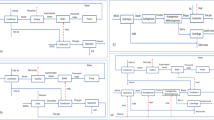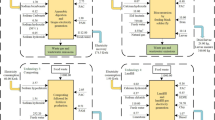Abstract
Purpose
Corncob as agricultural waste has dramatically increased in recent years. Some corncobs are recycled and reused as bioproducts, whereas a large amount remains unused and burned in the fields. Currently, furfural production technology is one of the most commonly used technologies for corncob valorization because furfural is one of the most promising chemicals for sustainable chemical production. However, very few studies have analyzed the impact of furfural and furfuralcohol production on the environment and economy via life cycle assessment (LCA) and life cycle costing (LCC). This study aims to quantify the environmental and economic impacts of furfural and furfuralcohol production, identify the main pollution processes and substances, improve potentials, and build a database on the furfural industry.
Methods
Life cycle assessment and life cycle costing were carried out to estimate the environmental and economic impact of corncob-based furfural and furfuralcohol production.
Results and discussion
The corncob production, transport, and electricity consumption stages had the greatest impact on the environment because of direct heavy metal, phosphate, and phosphorus emissions. The overall economic impact was mainly attributed to tax, corncob, transport, electricity, and infrastructure investment. Optimizing corncob transport, raw materials and consumption efficiency, and waste disposal is highly important in reducing both environmental and economic burden.
Conclusions
The key factors that contribute to reducing the overall environmental and economic impacts are increasing electricity consumption efficiency and furfural product yield, decreasing transport distance from corncob buyers to suppliers, choosing the appropriate corncob compression technology, and optimizing the wastewater reuse system.





Similar content being viewed by others
References
Bhaumik P, Laxmikant Dhepe P (2014) Exceptionally high yields of furfural from assorted raw biomass over solid acids. RSC Adv 4:26215–26221
Bozell J, Petersen G (2010) Technology development for the production of biobased products from biorefinery carbohydrates—the US Department of Energy’s “Top 10” revisited. Green Chem 12:539–554
Chen W, Xu C, Hong J (2014) Pollutants generated by cement production in China, their impacts, and the potential for environmental improvement. J Clean Prod. doi:10.1016/j.jclepro.2014.04.048
China Energy Statistic Yearbook (2013) National Bureau of Statistics of China. http://www.stats.gov.cn/tjsj/ndsj/2013/indexeh.htm
Cook R (2014) World corn production (1960–2014). http://beef2live.com/story- world-corn-production-1960-2014-130-108618
Cui X, Hong J, Gao M (2012) Environmental impact assessment of three coal-based electricity generation scenarios in China. Energ 45:952–959
Fan C, Qi K, Xia X, Zhong J (2013) Efficient ethanol production from corncob residues by repeated fermentation of an adapted yeast. Bioresour Technol 136:309–315
Frischknecht RS, Jungbluth N, Althaus HJ, Doka G, Dones R, Hellweg S, Hischier R, Humber S, Margni M, Nemecek T, Spielmann M (2007) Implementation of life cycle impact assessment methods, final report. Ecoinvent Swiss Centre for Life Cycle Inventories. Dubendorf, Switzerland
Goedkoop M, Heijungs R, Huijbregts M, De Schryver A, Struijs J, Van Zelm R (2009) A life cycle impact assessment method which comprises harmonized category indicators at the mid-point and the end-point level, first ed. ReCiPe. Report I: characterisation
Hong JL, Hong JM, Otaki M, Olivier J (2009) Environmental and economic life cycle assessment for sewage sludge treatment processes in Japan. Waste Manage 29:696–703
Hong JM, Zhou J, Hong JL, Xu X (2012) Environmental and economic life cycle assessment of aluminum-silicon alloys production: a case study in China. J Clean Prod 24:11–19
ISO 14040 (2006a) Environmental management—life cycle assessment—general principles and framework. Geneva, Switzerland
ISO 14044 (2006b) Environmental management—life cycle assessment—requirements and guidelines. Geneva, Switzerland
Jong W, Marcotullio G (2010) Overview of biorefineries based on co-production of furfural, existing concepts and novel developments. Int J Chem React Eng 8:A69
Lei C, Zhang J, Xiao X, Bao J (2014) An alternative feedstock of corn meal for industrial fuel ethanol production: delignified corncob residue. Bioresour Technol 167:555–559
Li N, Xiong X, Shao C, Chen S (2011) Adsorption of p-chlorophenol from aqueous solution on modified corncob. Fresen Environ Bull 20:747–753
Liu W (2010) Investigation and assessment on major crop’s energy consumption of Changyi City in Shandong. Master Dissertation Chinese Academy Agricultural Science
Mao L, Li A (2010) Life cycle assessment of furfural production and its pollution controlling. Chem Eng Prog 29:226–231
Marcotullio G (2011) The chemistry and technology of furfural production in modern lignocellulose-feedstock biorefineries. Published by Arkhé Edizioni - L’Aquila, Italy. ISBN 978-88-95207-49-0
RIRDC (2006) Furfural chemicals and biofuels from agriculture. A report for the Australian Government Rural Industries Research and Development Corporation. Publication No 06/127
Rong C, Ding X, Zhu Y, Li Y, Wang L, Qu Y, Ma X, Wang Z (2012) Production of furfural from xylose at atmospheric pressure by dilute sulfuric acid and inorganic salts. Carbohyd Res 350:77–80
Schryver A, Brakkee K, Goedkoop M, Huijbregts M (2009) Characterization factors for global warming in life cycle assessment based on damages to humans and ecosystems. Environ Sci Technol 43:1689–1695
Tao F, Song H, Chou L (2011) Efficient process for the conversion of xylose to furfural with acidic ionic liquid. Can J Chem 89:83–89
Wegener Sleeswijk A, Van Oers L, Guinée J, Struijs J, Huijbregts M (2008) Normalisation in product life cycle assessment: an LCA of the global and European economic systems in the year 2000. Sci Total Environ 390:227–240
Yan K, Wu G, Lafleur T, Jarvis C (2014) Production, properties and catalytic hydrogenation of furfural to fuel additives and value-added chemicals. Renew Sust Energ Rev 38:663–676
Acknowledgments
We gratefully acknowledge the financial support from the National Natural Science Foundation of China (grant no. 41101554); SRF for ROCS, SEM (grant no. 2011-1568); and the National High-Tech R&D Program of China (863 Program, grant no. 2012AA061705).
Author information
Authors and Affiliations
Corresponding author
Additional information
Responsible editor: Seungdo Kim
Rights and permissions
About this article
Cite this article
Hong, J., Zhou, J. & Hong, J. Environmental and economic impact of furfuralcohol production using corncob as a raw material. Int J Life Cycle Assess 20, 623–631 (2015). https://doi.org/10.1007/s11367-015-0854-2
Received:
Accepted:
Published:
Issue Date:
DOI: https://doi.org/10.1007/s11367-015-0854-2




